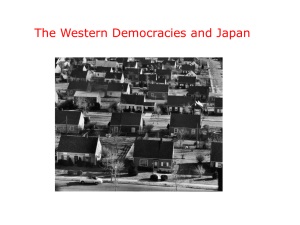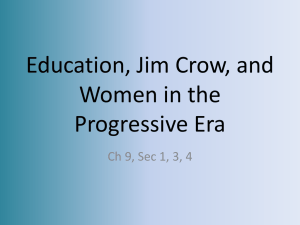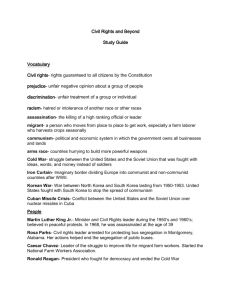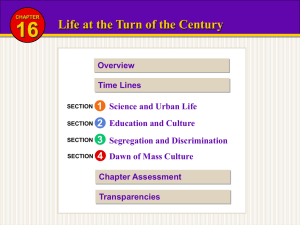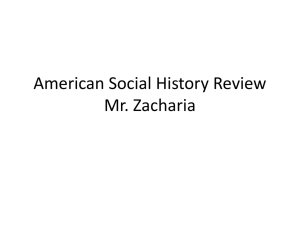The Industrialized Democracies
advertisement
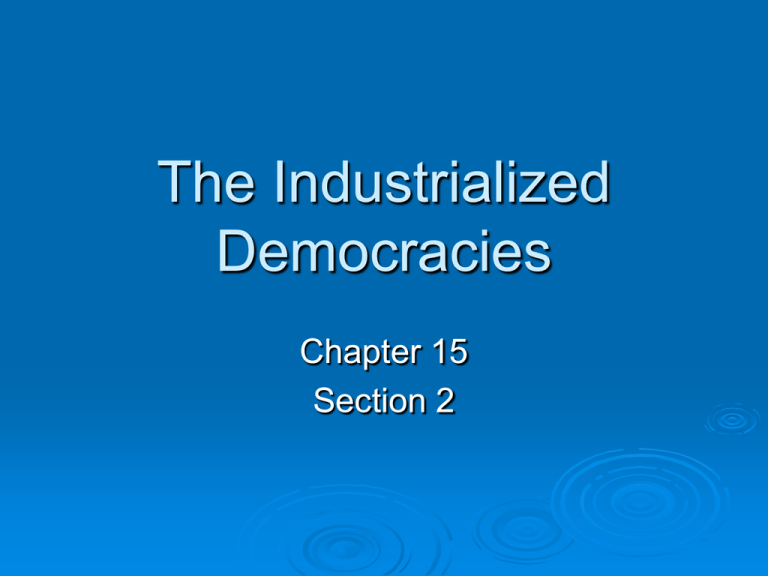
The Industrialized Democracies Chapter 15 Section 2 American Economy After WWII, U.S. businesses expanded into the global marketplace Other nations needed goods and services to rebuild This led to a period of economic success that changed life in the United States During the 1950s and 1960s, recessions (economic slowdowns) were brief and mild As Americans prospered, they left the cities to live in the suburbs which is called suburbanization Why Suburbanization? Americans took advantage of the growing economy Moved to single family homes Lawns Good schools Access to highways for work commute Suburbanization Suburbanization 1950’s stereotypical family Post-War Housewife Mom Hard at Work in the Fifties “Housewife” is an old, out-of-style term. Today, the terminology is “stayat-home mom” or “domestic engineer” Oil Crisis Job opportunities brought people to the Sunbelt region of the USA By the 1970s, countries in the Middle East placed an embargo on the USA The price of oil and gas rose substantially, which meant that people had less money to buy other consumer products This showed American dependence of oil. The decades of prosperity ended in 1974, with a serious economic recession Oil Oil Crisis Oil Crisis Energy Inefficient Home Sorry….no gas. Notice the large gas-guzzling cars of the 1970s. American auto manufacturers were years behind the Japanese in making smaller fuel efficient automobiles. Oil prices in the 1970’s Gasoline prices then and now Gasoline prices Discrimination and Segregation During the period of prosperity, African Americans and other minorities faced segregation in housing and education Blacks suffered from discrimination in jobs and voting Dr. Martin Luther King, Jr. emerged as the main civil rights leader in the 1960s During the 1960s, the U.S. Congress passed some important civil rights legislation Segregation Segregation Segregation Segregation Armed Forces Segregated Brown vs. Board of Education A 1954 landmark Supreme Court case that declared that segregated schools violated the United States Constitution. Dr. Martin Luther King Delivered the “I have a dream” speech in 1963. Major civil rights leader in the 1960s Dr. King organized boycotts and peaceful protests to end segregation in the USA. Positive Effects of Civil Rights Movement Congress passed new laws Public segregation outlawed Voting rights protected Equal access to housing and jobs But poverty, unemployment, and discrimination still affected minorities Women Rights Women faced gender discrimination Example: the women’s rights movement helped to end much gender-based discrimination in jobs and higher salaries Re-Building Western Europe W. Europe rebuilt after WWII The Marshall Plan helped restore European economies by providing U.S. aid After the war, Germany was divided between the communist East and the democratic West, but reunited at the end of the Cold War in 1990 Under Konrad Adenauer, West Germany’s chancellor from 1949 to 1963, Germany build modern cities and re-established trade Marshall Plan Aid to Western Europe Division of Germany into 4 Occupation Zones After World War II Konrad Adenauer Welfare States European governments also developed programs that increased government responsibility for the needs of people National Healthcare Unemployment Insurance Old-age Pensions These welfare states required high taxes to pay for their programs European Economy During the 1980s, some leaders, such as Britain’s Conservative Margaret Thatcher, reduced the role of the government in the economy Western Europe also moved closer to economic unity with the European Community, an organization dedicated to establishing free trade among its members Margaret Thatcher 1925-2013 European Economic Community Japan Japan prospered after WWII After WWII the Japanese Emperor lost all power. Japan’s new government was a parliamentary democracy. Japan Toyota Mitsubishi Sony Japan’s economy Its gross domestic product (GDP) soared GDP = The GDP of a country is defined as the market value of all final goods and services produced within a country in a given period of time Like Germany, Japan built new factories and produced cheap consumer goods American military protected Japan so Japan could direct more money to developing its factories Japan’s economy The Japanese government protected industries by raising tariffs on imported goods This helped create a trade surplus for Japan but angered the USA who wanted to export more to Japan Powerpoint Questions 1. What does recession mean? 2. Define suburbanization. 3. In what two areas did minorities face segregation? (2 points) 4. In what two areas did African-Americans suffer discrimination? (2 points) 5. Who was a leader of the American civil rights movement? 6. Identify the American plan to help re-build the European economies Powerpoint Questions 7. What West German leader helped re-build West Germany’s shattered economy? 8. What was the national goal of the “Welfare States”? 9. After many years, which British leader reduced the role of government? 10. What is the purpose of the European Community? 11. Define GDP. The End
